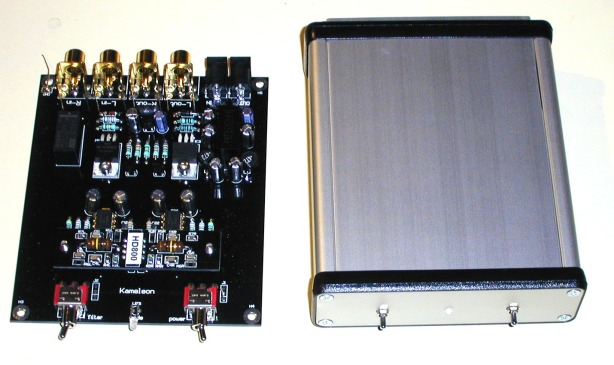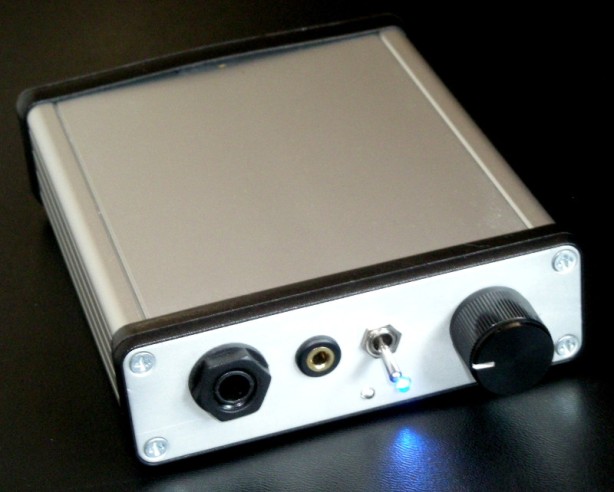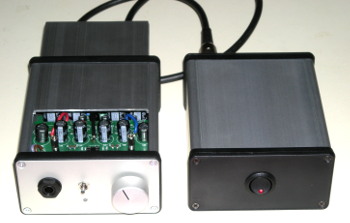Headphone related
published: Mar-11-2013, Latest update: Oct-17-2022
Headphone related stuff
to view the information click on the name of the headphone and you are linked to the page. That page can also be saved to your hard-disk if you want.
The first part is for an active filter that goes between a source and the input of a headphone amplifier and needs a power supply.
Below that section schematics for passive filters that go between the headphone out of an amplifier and the headphone itself and do not require any power supply.
Before contemplating using some of the ‘EQ’ possibilities that are listed below (active as well as passive) it may be a good idea to understand where all of these ‘compensations’ are based upon as not every one will be benefiting from a headphone that is EQ’ed ‘closer’ to ‘flat’. Some recordings won’t exactly sound ‘better’ with a proper EQ’ed headphone at all.
The ‘views’ where the filter circuits below are based on can be found in the first part of the measurement section HERE.
Please read it before jumping on the EQ or filter wagon.
In-line Kameleon filter
The in-line Kameleon filter is a custom equalizer with easy to insert modules that are purposely designed for specific headphones. The device goes between any source (as long as it is around line level) and your headphone amp.
It corrects the frequency response of certain headphones (those where filter-modules have been designed for) so the tonal balance becomes more even.
When you absolutely adore the tonal balance of your headphones as they are and like them for their coloration than this is not for you.
A commercial version of this design is available from Garage 1217
When you like your headphones but would love them to not have that peak in the treble or to have a better extension or more ‘correct’ tonal balance and you don’t want to (have) your headphones modified and don’t want (or can) use digital EQ then this might be your answer.

This is intended as a D.I.Y. project. Bare PCB’s (so without components) are available.
Ordering information, pricing of bare boards and stock see HERE
The construction manual for this can be downloaded HERE
Supported headphone list and more information is found HERE
A frequency response correcting portable amplifier

NOTE: I do not sell these amps nor can they be bought anywhere. It is strictly a Do It Yourself project. ONLY bare circuit boards are available, no kits or half finished products.
The Kameleon-2.1 portable headphone amplifier has some unusual properties.
This portable headphone amplifier is designed around 2 very capable op-amps (OP275/LM4562/LME49720 as input stage and OPA551 as output stage) and accepts filter modules.
Each headphone will have it’s own plug-in module that corrects (as closely as can be done with simple analog filters) the frequency response of that specific headphone.
Not all headphones can be corrected (or corrected well enough) but the better ones often can.
Of course the amplifier can also be used without a filter module and can act as a powerful portable amplifier with selectable gain and or bass boost for instance.
The amplifier is discussed in this thread in our FORUM.
Is your favorite headphone you want to use not (yet) listed in this ARTICLE then ask if it is possible to make a correction for that specific headphone in the FORUM.
This amplifier is a spin-off from the headphone correction filter PCB and has replaced it.

The v2.1 version has volume control + there is second a PCB that turns it into a much more powerful desktop amplifier with lots of protection circuits around it.
New filter PCB’s (backwards compatible) use easier to obtain SMD components + an added filter section so more complicated filters can be made.
Shipping costs depend on weight and destination. Goes through ‘normal’ mail in an envelope so NO exuberant shipping costs.
prices of bare (not populated) PCB’s & boards in stock (Jan 2019)
For those that have built this portable amplifier before June 2017 there should be an extra capacitor be added to the battery management part (has no influence on sound).
When this extra capacitor is added the ‘battery empty’ detection will function better.
How to install this extra capacitor (not needed for the desktop version) is shown in THIS pdf.
In the latest v2.1 board the modification is already present.
When you want to buy bare boards (without components) contact ‘Solderdude’ via the contact form or via the forum.
Note, if you have a favorite headphone and like exactly how it sounds then this amplifier is NOT for you (unless you use the ‘flat’ module’).
When you really like your headphone BUT you find it lacking in the areas where the Kameleon addresses it you may enjoy it even more.
Below a few plots of a few headphones in stock form and playing through the Kameleon amplifier with their correction modules in place.
Beyerdynamic DT1350 with EDT1350-NL pads

Sennheiser HD800

.
.
.
Filter modules have been created for many more headphones. More information HERE
Active headphone correction filter board
Instructions and information about this Headphone Correction Filter PCB can be viewed/downloaded.
View/download the latest version (19-Mar-2015) HERE it includes parts lists for 40 popular headphones.
All PCB’s are sold. No longer available.
Note that an older (and smaller) PCB used to be available. The BOM-lists for the NEW PCB differs from the one needed for the older PCB. SOME designators (part numbers) differ. IF you need a BOMlist for the old PCB contact me (Solderdude) and I will e-mail it to you.
Some reasons WHY you would want to use a correction circuit
Frequency Range is not the only factor that determines SQ BUT it is the biggest contributor to differences in sound.
The FR can wobble many dB’s in different areas over the audible FR. This may reach well over 10dB (in small bands). 10dB is (roughly) a halving or doubling of perceived level. Some headphones are even skewed well over 20dB or have sharp dips or peaks of over 30dB !
Of course FR is NOT the only important sound determining factor, distortion is an important factor as well as well as ‘speed’.
Distortion of bass can be as high as 10-50% (yes, you read that well) and in some cases 3rd harmonics are louder than the 2nd harmonics which isn’t liked by many people.
Distortion in the mids can also be as high as 1% in specific small bands.
Yes, 1% is audible… everything below 0.01% is not audible any more as the distortion is relative to the SPL in all cases (unlike with amps). On top of that distortion also differs with different amplitudes and this is where the better cans usually are better.
These are all ADDED harmonics and some of them can be quite nasty sounding.
Tube amps ALSO add distortion but always with a ‘nice’ signature, 2nd harmonic is relatively high (depending on output level of an amp between 0.01% and 1%), 3rd harmonic is already much lower in amplitude and the higher ones may already even disappear in the noise floor. This is perceived as a ‘nice/natural sounding addition’.
Then there is also the ‘speed’ and ‘resonances’ that affect the sound. If a membrane can move fast and stop fast and can reach the SPL level that corresponds with the applied voltage immediately, it will have less distortion and be more accurate (true) to the applied waveform. This too has an effect mostly on subtle cues in the music.
With all these factors combined is obvious that you need a GOOD design that already performs well and if that has screwy FR one only needs to compensate for that and what you get is a stellar performer.
Do the same to a crappy performing driver and you only end up with an improvement but not stellar performer.
For this reason I do not recommend to apply compensation to ‘lesser’ models and only correct the better headphones that have good qualities already and just need a nudge in the FR area. Given the price of such a correction circuit when built in an enclosure with a power supply it only is sensible to improve ‘good’ headphones and make them stellar.
Headphones that can be corrected with this circuit
AKG K501
AKG K550 / K551
AKG K601 / K612
AKG K701 / K702 / Q701
Audeze LCD2 / LCD2-rev2 / LCD3 / LCD-X
Audio-Technica M50 (old & 2012 version)
Beyerdynamic DT770 Pro
Beyerdynamic DT880 (32 & 250 Ohm)
Beyerdynamic DT880 (600 Ohm)
Beyerdynamic DT990 Pro
Beyerdynamic DT1350
Beyerdynamic DT1350 with HD25 pads (doubling as headphone amplifier)
Beyerdynamic T1
Beyerdynamic T5P
Beyerdynamic T70 / T70P
Beyerdynamic T90
Denon D2000 / D5000 / D7000
Fostex T20RP-mkII / T40RP-mkII / T50RP with Shure SRH940 pads and modifications
Fostex T50RP with Shure SRH940 pads and modifications & Mr.Speakers Mad Dog (alternative T50RP filter)
Fostex T20RP-mkII / T40RP-mkII / T50RP with Beyerdynamic DT770 pads and modifications
Fostex T50RP modified by Paradox Audio – Paradox (or use the alternative T50RP filter above)
Grado PS1000
HiFiMan HE5 / HE6 / HE-500
JPS labs Abyss AB-1266
KEF M500
Sennheiser HD558 / HD598
Sennheiser HD580 / HD600
Sennheiser HD650
Sennheiser HD800
Sennheiser Momentum (ONLY over-ear version)
Shure SRH-840
Shure SRH-940
Shure SRH-1840
Sony MDR-1R NC (with Noise Cancelling ‘on’)
MODIFICATIONS + ACTIVE FILTER
Fostex T50RP modifications using Shure SRH-940 pads.
Create a more than excellent sounding orthodynamic headphone.
modifications and description/schematics for a dedicated active filter.
This is a revised version of my first attempt with different filter and using SRH-940 velour pads.
Expanded with some measurements and new insights.
Fostex T40RP-mkII modifications using Beyerdynamic DT770 pads.
Create a fantastic sounding orthodynamic headphone for relatively small amounts of money.
modifications and description/schematics for a dedicated active filter.
This is a revised version of my first attempt with different filter and using DT770 velour pads.
Expanded with some measurements and new insights.
AKG K551 modifications. Transform this headphone in a stellar performer… think K501 with bass extension !
NOTE: The felt discs needed for modification can be ordered via the FORUM.
Sennheiser HD650 modifications measured.
A quite lengthy (53 pages) and in-depth report of measurements to the HD650 and various modifications.
Big file size … 9MB
Sennheiser HD-438 with a more balanced signature, the darker typical sennheiser signature is transformed into a more realistic and clear sounding set of cans !
Here are instructions how to take it apart and mod it (and get rid of the ‘spokes’)
Superlux HD562 is an HD 25 ‘clone’. The article is an evaluation and comparison against the original Sennheiser HD25
There are no modifications in this article.
Superlux HD662-EVO measurements and very easy to apply modifications resulting in the best headphone Superlux has produced over the years.
Excellent sound quality that won’t disappoint once modified.
Punches well above the sound quality of much more expensive headphones.Better sounding than a modified HD681 or HD681-EVO… much more musical and dynamic.
Superlux HD681-EVO modifications and filter circuit. The Superlux HD681-EVO is an ‘upgraded’ but very different sounding versions as the ‘original’ HD681. It has great modifying potential though and can easily be turned into a better (read flatter / more accurate) headphone with very present mids as opposed to the overly warm/dark sound of the stock version. This tutorial shows what needs to be done. It can be discussed HERE. For the price and a few $ added for some components/Chinese e-bay pads this headphone is a no-brainer. The article has been updated with information about the ‘newer’ model HD681-EVO that comes with velvet pads and has had a few minor changes. Another trick to improve the treble/imaging is added as well.
Also added some info on a modification with cheap pads from e-bay which work wonders on these headphones.
Superlux HD681…. revisited for less over the top bass and highs (I use this filter myself)
Only disadvantage… this particular filter only works correctly on low Ohmic amplifiers such as portable gear and most over the counter headphone amplifiers.
Very balanced sound, more open sounding, nicer mids. IMO better than a modified HD681-EVO and cheaper as well.
For building into the HP itself or in between the HP and amplifier.
Superlux HD681 replacement pad measurements.
Various pads that can be used on the HD681 (and HD681-EVO, HD668B e.t.c.) are measured and discussed.
Superlux HD-685 evaluation and modifications.
Superlux HD-661 evaluation and filter modification.
cures listening fatigue yet the sonic character remains untouched.
Samson SR850 correction filter
For building into the HP itself or in between the HP and amplifier.
more highs extension and peak is lowered.
Much smoother and extended highs.
Jays V-Jays filter.
For incorporation in the headphone wire (or in a small extension cord) between the headphone and player/amp.
More highs and the higher mids peak is reduced. Overall better sound.

Headphones can also be connected to speaker amplifiers.
Some inefficient and high power headphones (very high impedance or high power rated orthos) as well as electrostatic/electret headphones connected via an adapter can be connected directly (when the amplifier is NOT a bridged version).
Other headphones can be connected via a power adapter which you can make yourself.

If you need a passive adapter because your amplifier has an audible hiss on your sensitive headphones or want to protect your low power rating ear/head-phones from being blown up by a high power headphone amp.
Or you want more ‘range’ on your volume control and not just use the first few mm of ‘movement’ then you need a passive adapter.










Hello just wanted to give you a quick heads up and let
you know a few of the pictures aren’t loading correctly.
I’m not sure why but I think its a linking issue.
I’ve tried it in two different browsers and both show the same results.
You are correct Korey, it is very annoying and have experienced this too sometimes, even on different computers/locations/browsers.
Alas there is nothing I can do about it. The pictures are stored on the same server as this blog/website.
What usually helps is pressing F5 (reload or refresh) or click one of the ‘flattened’ pictures so it is displayed. After that the other pictures load fine as well. No idea why that is though.
I learned a lot from this post,
thanks guy.
I just got the shure srh940 and they are amazing. I see that is a headphone this amp corrects, but I don’t see a graph or where to buy the amp with that module. I’m very interested!!!
There is no graph because I did not measure it. The corrections for it are based on my hearing them (elsewhere) and known measurements. For the USA region the amps could be built by Garage1217, for European customers it is best to contact me (solderdude) via the forum ( http://diyah.boards.net/ ) or the contact page.
There are no distributors or importers, for now a DIY project where it is possible to have (experienced) builders to build one for you.
These can be contacted via the forum.
Sorry, that’s the only way, at least for now.
The 2 links: “modify the Superlux HD681, step by step guide” and “Superlux HD681…. revisited ” don’t work anymore. Could you fix or send the files per mail?
Someone flagged it so it is blocked for some reason.
When you use the contact form I can mail it to you.
Seen the K361 today. Thanks a lot. Err… Do you plan to test a 712 Pro sooner or later?
Thanks a lot for all this sum of information.
Depends on if someone sends one in for measurement. I suspect they are similar to the K7XX but have less bass and lower mids because of different pads. Can only say for sure when I get my hands on one.